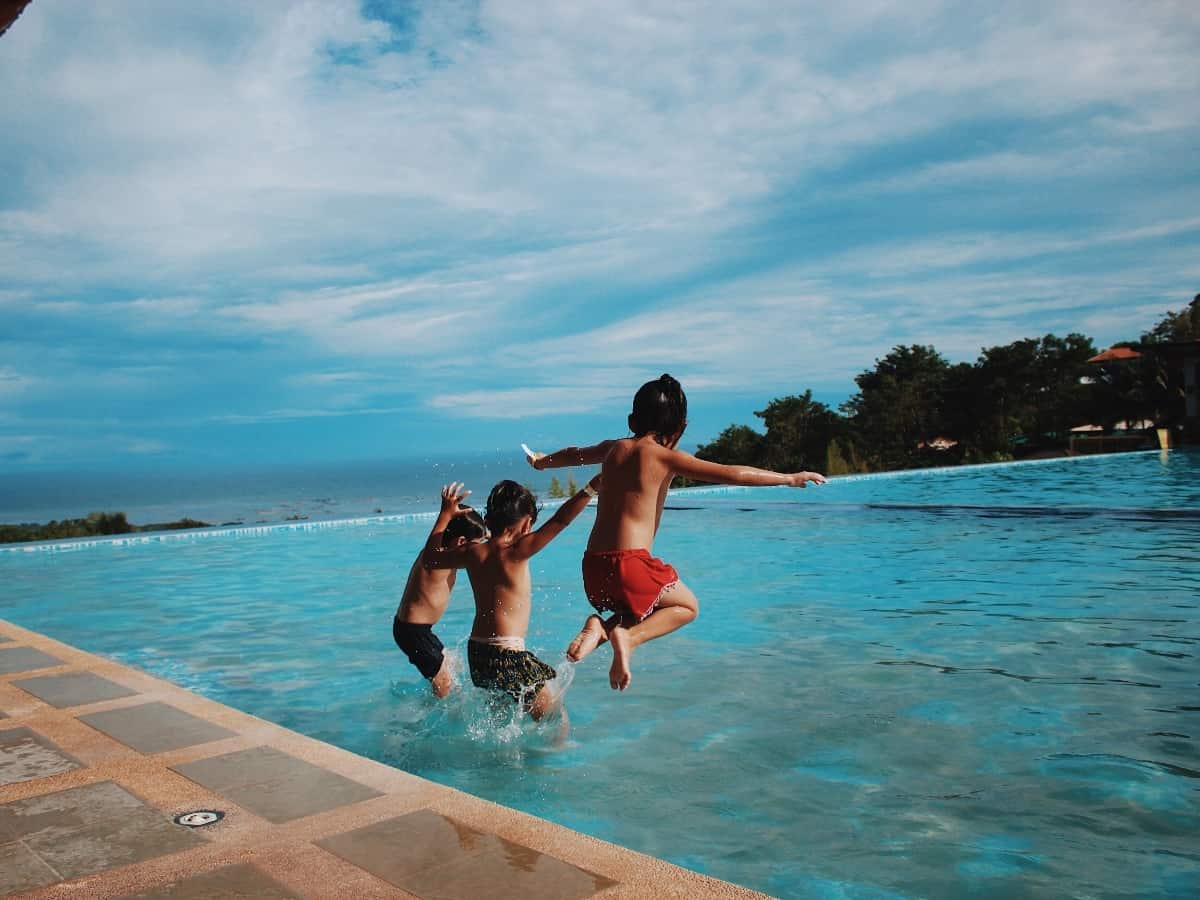There is nothing more satisfying than taking a dip in a pool to escape the summer heat. Although swimming in a pool is refreshing and relaxing, you should always be aware of the power of water. Unfortunately, accidents happen. However, with some information about pool safety, you can take the necessary steps to protect those around you this summer.
The Centers for Disease Control lists drowning as the number one cause of injury related deaths in children between the ages of one and four years of age. Drowning is the second primary cause of accidental injury death in children between the ages of one to 14 years of age. Adults are just as susceptible to drowning as children. It’s important for everyone to do what they can to stay safe while in a swimming pool. There are a number of things people need to be aware of before they enter a pool. Here are some pool safety tips to help keep you and your family safe this summer.
A False Sense of Security
Children of all ages love to splash around in pools during the summer months. You have probably seen parents holding their kids in the water, oftentimes they are wearing their flotation devices. When kids are with their parents, it’s easy to assume they’re safe and properly protected.
The reality every parent has to face is that they are not with their children 24/7. Parents are not always around when their children are splashing or swimming around in a swimming pool. This means they have to rely on someone else to supervise them. Accidents can happen in situations where one person is responsible for supervising more than one child. You should make sure that the people you let into your home to care for your children are aware of pool safety rules. They should also know how to swim, and institute life-saving measures like CPR.
You have probably seen a lot of parents and other adult figures who leave children unattended while they splash around in wading pools. Many people believe that this practice is safe, and harmless. The reality of leaving a child in any type of pool whether it is one of the plastic ones that can be bought from a department store, or an in-ground pool is dangerous. It can’t be impressed upon people enough that children and adults can actually drown in a very small amount of water. According to the Surfer’s Medical Association, a person of any size can actually drown in as much as two milliliters of water per kilogram of the weight of their bodies.

What You Need To Know About Injuries that Occur in Your Pool With Your Homeowner’s Insurance
During the summer months, people are always looking for a place they can hang out to keep cool. It is perfectly fine to invite some family members and friends over for a swim to beat the heat. You need to make sure you understand the terms and conditions of your homeowners insurance policy.
What Your Homeowner’s Insurance Covers
You need to be aware of the terms and conditions relating to the type of insurance coverage you need. Insurance requirements are determined by several factors. Some insurance policies cover swimming pools as external structures. Depending on the insurer, coverage could be denied if:
- There are slides or diving boards present
- Pools are not filled with water at all times
- There is not at least a four foot fence with a secured gate
Some insurers also classify insurance coverage for in-ground pools. Some other policies cover above ground pools. Coverage A classification considers in-ground pools as dwellings. Coverage B labels in-ground pools as other structures. Most insurers cover pools above the ground. These types of pools are categorized as personal property.
Many people have questions about whether insurers cover leaks. Insurers tend to limit coverage to events that are generally covered, like leaks caused by windstorms and fire. It is not typical for insurance companies to pay for any damages which fall outside those perimeters. Insurers generally do not cover damages that are incurred due to poor maintenance and normal wear and tear. Pool liners may be covered if it sustains damage caused by a windstorm or other covered event.
Beyond covering your swimming pool for any damages it sustains, your homeowner’s insurance also provides liability protection. With that being said, depending on the severity of the injury a person sustains while swimming in your pool, there may be some fairly hefty medical and legal expenses coming your way. It is always a good idea to sit down and speak with your agent, so they can assist you in determining whether you have enough coverage to protect you and your property should the unthinkable happen.

What Should Your Liability Amount Be?
Most homeowners policies offer a base liability amount of $100,000, however it is important to mention that a pool increases a homeowner’s liability risk. It is always better to be on the side of caution and increase your liability coverage to at least $300,000 or more depending on the items you need to protect according to the Insurance Information Institute (III). The III also recommends homeowner’s check with their local municipality to get an understanding of the ordinances and other information pertaining to home swimming pools and pool safety.
Add Extra Protection: Purchase an Umbrella Policy
Choosing to add an umbrella policy to your homeowner’s policy helps to secure your investments. Umbrella policies go over and beyond the limits of a regular homeowners’ policy. This type of insurance protection is there to help protect homeowners when they have run out of the amount of insurance that is required by the amount of the homeowner’s policy.
Plan and be Proactive
There are several things you can do as a homeowner to protect yourself, your family and your property should someone be injured. The first thing you need to do is establish the rules and boundaries of your space. Post them clearly, so they are in plain sight. You should make sure that you enforce the rules at all times. Insurance companies tend to be more amenable in regard to paying claims when homeowners have erected a barrier. Fences and privacy fences to keep unwanted guests out of their pool area are safe bets.
What Else Should You Add For Pool Safety?
Here are some additional items and tips to consider adding to prevent injuries and increase pool safety.
Make Sure Your Guests Know How to Swim
You should make sure the people you allow in your pool actually know how to swim. It is very easy for people to get distracted and become panicked when they are in water. Not knowing how to swim only compounds the situation. In addition, if parents are bringing their children along for a dip in your pool, you should remind them that they need to make sure their children are supervised at all times. Reminding parents that floatation devices are not a substitute for supervision should be included in your pool safety plan.
Teach Them Early
Children don’t have the ability to recognize danger the way adults do. They are generally unsuspecting when it comes to danger. One of the best things you can do if you own a swimming pool is to teach your children how to swim as soon as possible. It is easier to teach younger children how to swim. The reason is that they haven’t had the opportunity to develop a fear of the water.
Does Anyone Know How to Do CPR?
Everyone in your family has a working knowledge of the basic skills necessary to rescue someone from the water if necessary. You should either purchase or make a first aid kit. Keep your kit in an area near the pool. Make sure it is accessible to those who use the pool.You and members of your family who are old enough to take CPR should do so as well.
Place Life-Saving Tools Near the Pool
Make sure items like reaching poles, ring buoys and a list of emergency numbers are kept near the pool. You and members of your household should also know how to disable filters, and other devices.
Keep Alcohol Away
The CDC cites that alcohol is associated with nearly 50 percent of the water recreation deaths of adults and adolescents. Alcohol, even in smaller amounts can affect judgement. It lessens the ability for a person to balance themselves. And alcohol makes it difficult for people to maintain their coordination. It is also a fact that alcohol and heat don’t mix. Make sure you keep family members and guests who have been drinking away from the pool.

It is Possible to Drown and Not Know It
One of the most important things about pool safety involves gaining an understanding about what drowning is and the symptoms associated with it. Drowning is a general term that is used to describe an unintentional injury in a swimming pool. Sometimes people are submerged underneath the water for a short period of time, and in other situations, people can drown as the result of taking in too much water at once.
Dry Drowning
Dry drowning is a term that has gotten a lot of hype in recent years, however, the medical director of LG Health Urgent Care Centers, Dr. Vito DiCamillo stated that the term of dry drowning is not correct. He describes the instances that are referred to as dry drowning as multiple instances of swallowing or choking on water while swimming. Symptoms associated with this phenomenon include:
- Difficulty breathing
- Chest pain
- Cough
- Fever
- Rapid breathing
Dr. DiCamillo further suggests that parents need to make sure they monitor children who have been involved in a drowning event, even if they appear to be okay, because water that has been aspirated into the lungs can cause damage.


